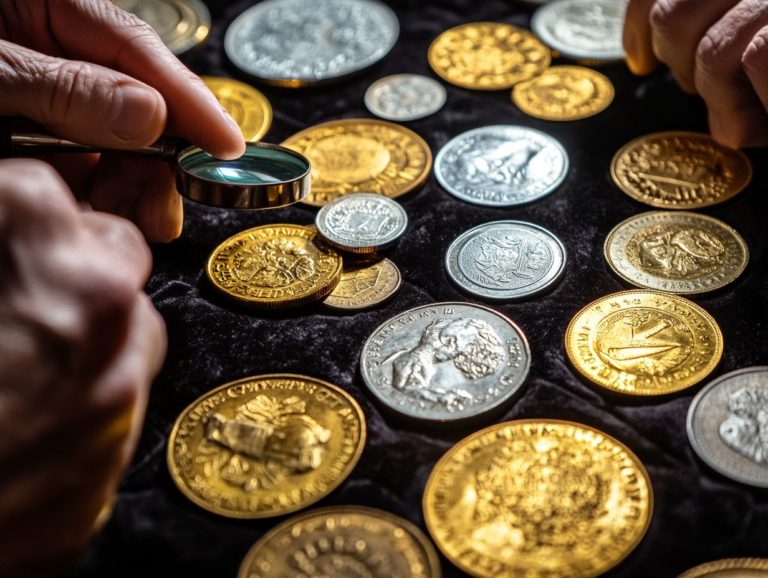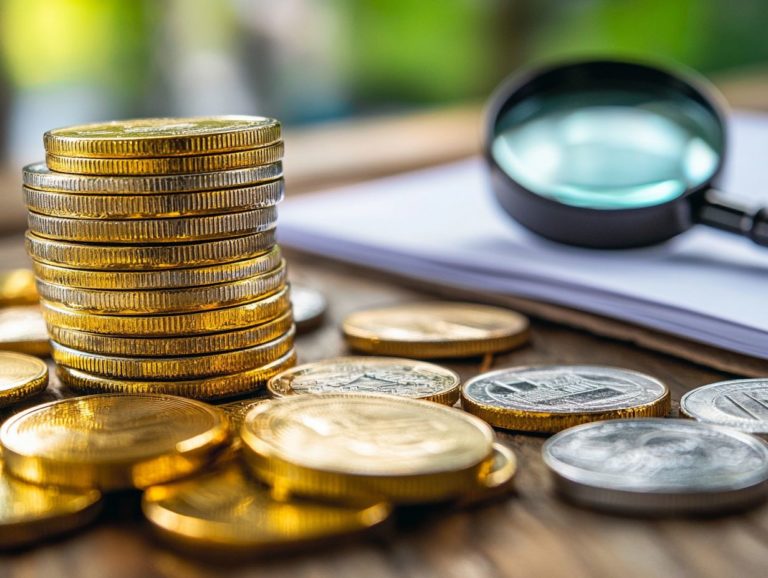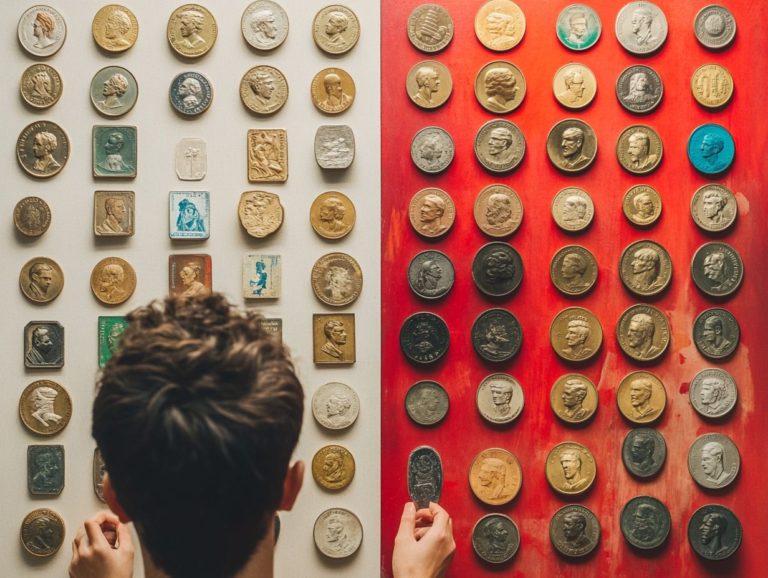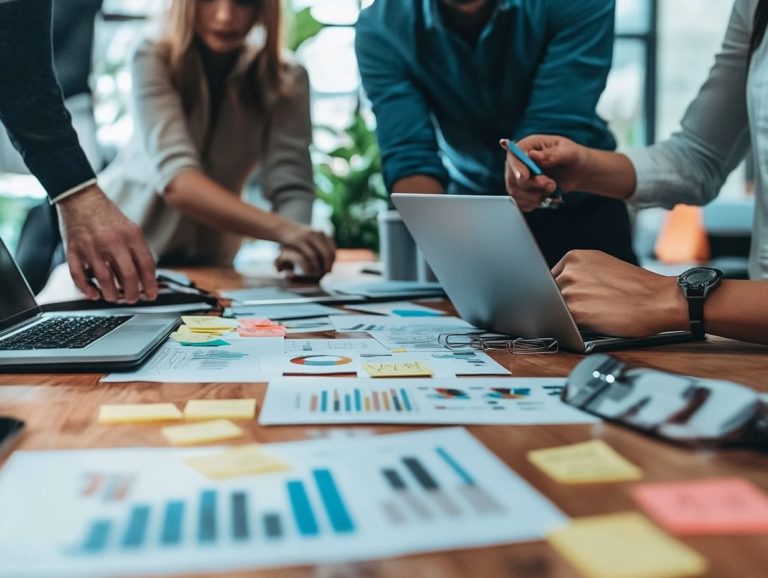What Criteria to Use for Precious Metals Investment?
Investing in precious metals can be a dynamic opportunity! Throughout history, these assets have served as a reliable safeguard for preserving and growing wealth.
In a landscape marked by fluctuating market trends and economic uncertainty, understanding the nuances of precious metals is crucial for investors.
This article explores the nature of precious metals, guiding you through key factors to consider before making an investment from current market conditions to the various types available.
You ll discover the benefits they offer, including diversification and protection against inflation. It will also address the inherent risks and outline essential criteria for selecting the right metals to enhance your investment portfolio.
Contents
- Key Takeaways:
- Factors to Consider Before Investing
- Benefits of Investing in Precious Metals
- Risks and Challenges of Investing in Precious Metals
- How to Choose the Right Precious Metals for Investment
- Frequently Asked Questions
- What Criteria Should I Use for Precious Metals Investment?
- What are the different types of precious metals?
- What factors should I consider when choosing a precious metal to invest in?
- What are the benefits of investing in precious metals?
- What are some potential risks of investing in precious metals?
- What are some common ways to invest in precious metals?
- How can I determine the value of my precious metals investment?
Key Takeaways:
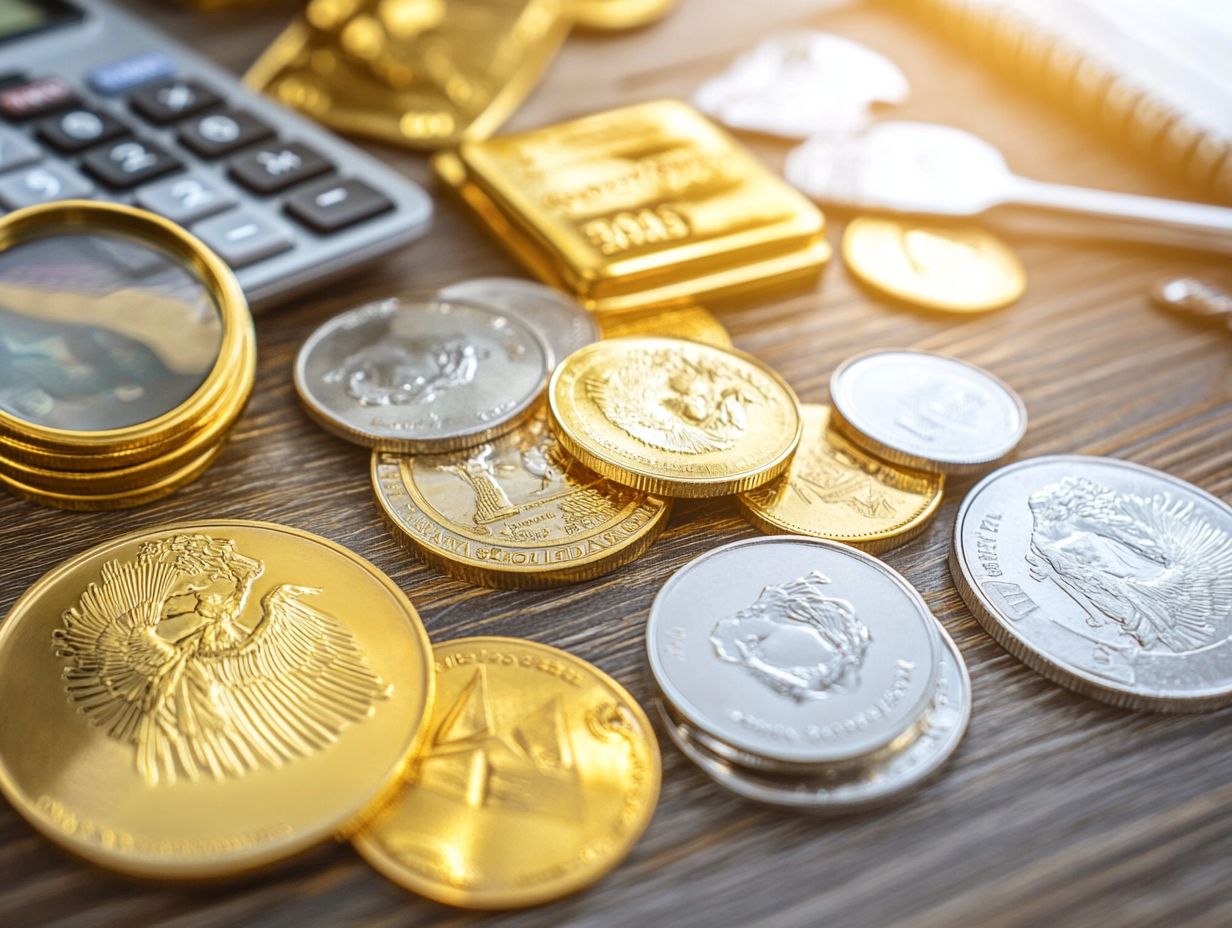
Protect your wealth! Diversifying with precious metals can shield you from inflation and market swings. Remember to consider market trends and liquidity when investing.
What are Precious Metals?
Precious metals are naturally occurring metallic elements that are rare and possess high economic value. They primarily serve as investments and fulfill various industrial roles.
The most notable among them gold, silver, platinum, and palladium each presents unique properties and market dynamics that can attract your investment eye.
These metals are not just staples in jewelry and electronics; they also play a crucial role in diversifying your investment portfolio and hedging against economic uncertainty.
Their historical significance stretches back to ancient civilizations, where they served as currency and found their way into artwork, religious artifacts, and trade.
Today, precious metals remain relevant due to their industrial applications, such as in catalytic converters for vehicles and advanced electronic devices.
When the market becomes volatile, savvy investors often flock to these metals, recognizing their remarkable ability to retain value despite economic fluctuations.
By incorporating precious metals into your investment strategy, you can enhance your overall financial stability, making it a wise choice for anyone aiming to safeguard their assets.
Factors to Consider Before Investing
Before diving into investing in precious metals, consider several important factors that will affect your investment choices.
Market trends and economic conditions are key players in determining the prices of gold, silver, platinum, and palladium, ultimately influencing the potential returns on your investment portfolio.
Engaging with a financial advisor can provide personalized investment strategies that align seamlessly with your financial goals and risk appetite.
Market Trends and Economic Conditions
Market trends and economic conditions serve as pivotal forces shaping the prices of gold, silver, platinum, and palladium essential considerations for anyone contemplating an investment in precious metals.
These trends can shift swiftly due to factors such as inflation, geopolitical tensions, and the monetary policies of central banks, leading to market volatility that requires careful navigation.
Economic indicators like interest rates, employment statistics, and consumer spending significantly influence the demand for these metals, ultimately affecting their market value.
For example, during uncertain times, precious metals often emerge as a safe haven, making them valuable assets to enhance your investment portfolio.
By staying attuned to both current events and enduring economic patterns, you can make informed decisions that align with your long-term financial aspirations.
Start your journey into precious metals investing today consult with an expert to tailor your strategy!
Types of Precious Metals

There are several types of precious metals. Each has unique characteristics and investment options for different investor profiles.
Gold is often seen as the ultimate safety net during economic downturns. It s a popular choice for those looking to preserve wealth.
Silver serves two purposes: it s both an investment and an industrial commodity. This appeals to those interested in versatile assets.
Platinum and palladium are essential in the automotive sector. Their demand fluctuates based on market conditions and environmental regulations.
If you re adventurous, consider less common metals like rhodium and iridium. They present intriguing opportunities but come with higher volatility.
Incorporating these precious metals into your diverse portfolio can enrich your investment options. This helps balance risk and reward in a changing market.
Benefits of Investing in Precious Metals
Investing in precious metals offers numerous advantages. They are valuable assets for your investment portfolio.
One major benefit is diversification. These metals protect against market volatility and economic downturns.
They also help preserve your purchasing power during uncertain times. This makes them reliable for investors seeking both stability and growth.
Diversification and Inflation Protection
Diversification is key to smart investing. Adding precious metals to your portfolio strengthens your defense against market volatility.
These metals often move differently than stocks, providing a unique asset class. They also protect against inflation, ensuring your investment’s value lasts over time.
Assets like gold and silver can buffer during economic recessions. They usually maintain value while stocks can fluctuate wildly.
As inflation rates approach 5% annually, your cash’s purchasing power diminishes. In these times, precious metals become essential for a balanced investment strategy.
Risks and Challenges of Investing in Precious Metals
Investing in precious metals presents opportunities but also unique risks. It s crucial to navigate these carefully.
Market volatility leads to price fluctuations. Develop robust investment strategies to manage this risk.
Liquidity concerns and currency exchange risks can affect your buying and selling of these metals. Smooth transactions at advantageous prices may be challenging.
Market Volatility and Liquidity

Market volatility means rapid changes in asset prices. This is especially true for precious metals, influenced by geopolitical risks and economic uncertainty.
This volatility can make buying or selling precious metals challenging. Your investment risks may increase during turbulent market conditions.
As an investor, you face sudden price swings and uncertain liquidity. In crises, demand for these assets surges, but supply can tighten.
To mitigate these risks, consider:
- Diversifying your portfolio with physical metals and financial instruments.
- Creating watchlists for strategic entry points.
Maintaining a flexible investment horizon will help you navigate extreme market behavior.
How to Choose the Right Precious Metals for Investment
Selecting the ideal precious metals for investment requires careful consideration, taking into account several crucial criteria that align with your financial aspirations and risk tolerance.
Key factors, including prevailing market trends, the unique characteristics of each metal, and their historical performance, play a significant role in shaping your investment choices. By carefully evaluating these elements, you can ensure that you choose the most fitting options for your portfolio.
Key Criteria for Selection
When selecting precious metals for investment, evaluate several key criteria, including the current market prices for gold, silver, platinum, and palladium, as well as their historical performance trends.
Understanding these metrics gives you the power to formulate sound investment strategies and make informed decisions that align with your financial goals.
Diving into market demand and supply dynamics, along with geopolitical factors, is essential for predicting future price movements. Pay close attention to big economic trends like inflation rates and currency fluctuations, as these can significantly influence precious metal pricing.
By examining past performance during economic downturns or booms, you can uncover valuable insights into how these metals respond to varying market conditions. This approach helps you build a strong portfolio that not only meets your investment objectives but also protects you from sudden changes in the market.
Frequently Asked Questions
What Criteria Should I Use for Precious Metals Investment?
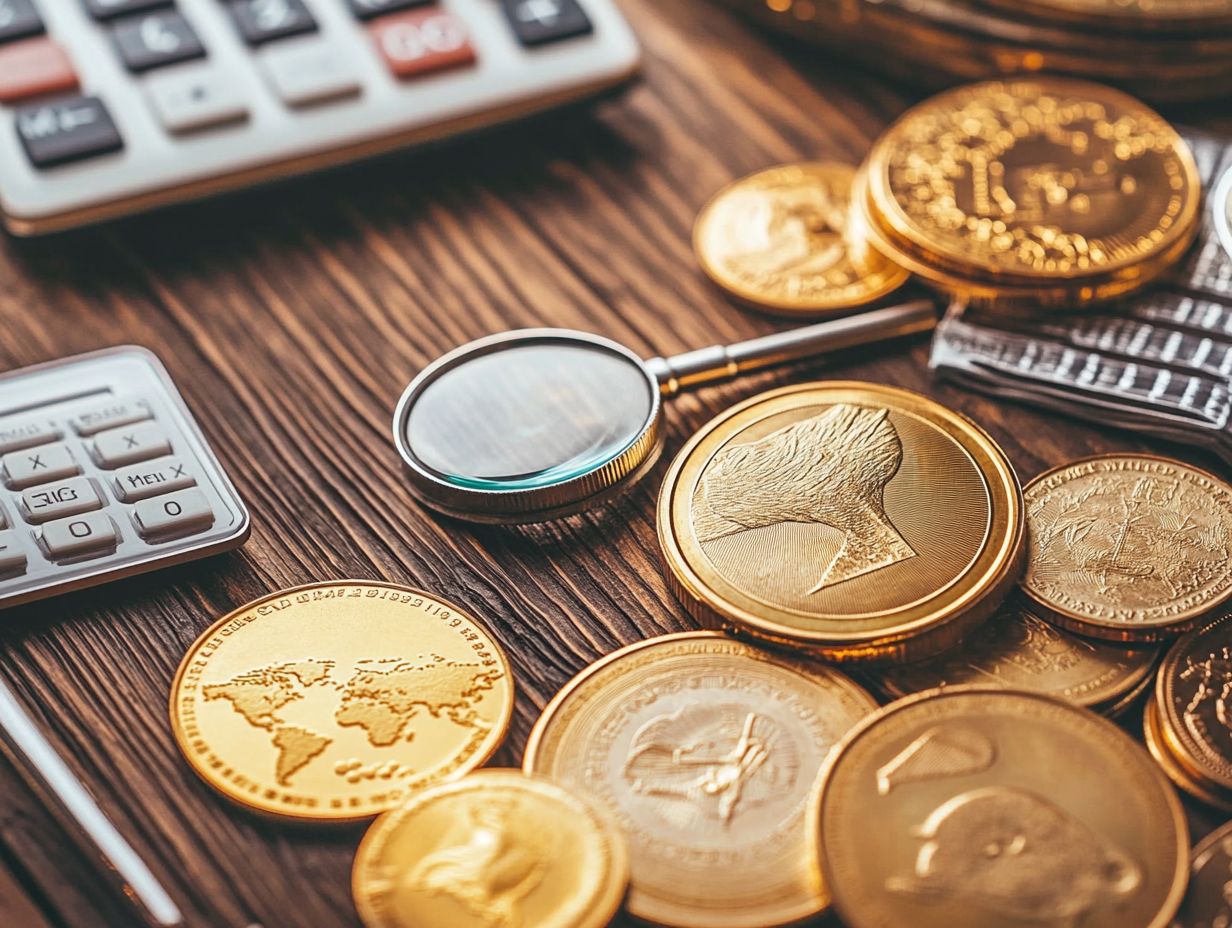
When considering investing in precious metals, it’s important to have a set of criteria in place to guide your decision-making process. Here are six frequently asked questions about what criteria to use for precious metals investment.
What are the different types of precious metals?
There are several types of precious metals commonly invested in, including gold, silver, platinum, and palladium. Each metal has its own unique properties and uses, making them attractive options for investment purposes.
What factors should I consider when choosing a precious metal to invest in?
When deciding which precious metal to invest in, consider factors such as market demand, current prices, and future growth potential. Research the metal’s historical performance and its role in the global economy.
What are the benefits of investing in precious metals?
Investing in precious metals brings exciting benefits, such as a hedge against inflation, portfolio diversification, and a potential store of value. Precious metals are also easy to sell, meaning they can be converted to cash if needed.
What are some potential risks of investing in precious metals?
As with any investment, risks are always involved. Some potential risks of investing in precious metals include fluctuating market prices, economic instability, and geopolitical factors. It’s important to carefully consider these risks before making any investment decisions.
What are some common ways to invest in precious metals?
There are several ways to invest in precious metals, including purchasing physical bullion, buying stocks of mining companies, and investing in exchange-traded funds (ETFs) or mutual funds that track the performance of precious metals.
How can I determine the value of my precious metals investment?
The value of your precious metals investment depends on several factors, including the type of metal, current market prices, and any transaction or storage fees. You can also track the performance of your investment over time by monitoring market trends and staying informed about economic news and events.


